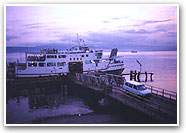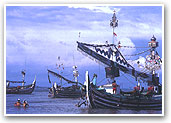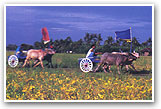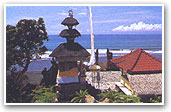| Jembrana
 The district
of Jembrana is a rugged area covering a large strip of the
southwest coast of Bali. The western tip of the island is
separated from East Java by a narrow strait, serviced by a
regular ferry service between Gilimanuk, and Ketapang. The district
of Jembrana is a rugged area covering a large strip of the
southwest coast of Bali. The western tip of the island is
separated from East Java by a narrow strait, serviced by a
regular ferry service between Gilimanuk, and Ketapang.
Legend has it that Bali was once joined to
Java here by a narrow piece of land, until one day a
distinguished Javanese priest of great powers banished his
badly behave son to Bali, drawing a finger across the
connection sands and cutting Bali off from the "mainland" of
Java. Indeed, geological evidence proves that there was once a
land connection. The strait is lees than three kilometers at
is widest point and in some places reaches only 60
metres.
An enterprising Buginese prince from
Makasar named Kapiten Patimi set himself up during the
17th century as ruler of Jembrana. He was tolerated
by the Badung royalty, who basically considered Jembrana as an
appendage of their own extensive realm. At the turn of the
19th Century the Raja of Karangasem, having conquered both
Buleleng and Lombok, proceeded to covet Jembrana, and actually
succeeded in taking over for a stage, much to the chagrin of
Badung.
The Dutch military expedition of 1846-49
enabled the colonials to exert an increasing degree of control
over northern and western Bali. In 1847 the Raja of Jembrana
finally relinquished his kingdom to the Dutch who appointed a
"puppet" member of the royal family a Regent.
 Independence
brought increased prosperity to Jembrana, and the narrow strip
of the coastal land is now intensively cultivated. Large
coconut plantations back onto a range of mountainous jungle.
The most important and largest fishing port in Bali is at
Pengambengan just ten kilometers southwest of the major town
of Negara, within view of the nearby coast of Java. The local
fishermen here, using large motorized perahu, catch quantities
of sardines in the triangular area of Indian Ocean between
Bali and Java known as Selat Bali. There are several large
canneries right on the beach at Pengambengan. Prawn-breeding
is also a small industry with tremendous potential in this
area. Independence
brought increased prosperity to Jembrana, and the narrow strip
of the coastal land is now intensively cultivated. Large
coconut plantations back onto a range of mountainous jungle.
The most important and largest fishing port in Bali is at
Pengambengan just ten kilometers southwest of the major town
of Negara, within view of the nearby coast of Java. The local
fishermen here, using large motorized perahu, catch quantities
of sardines in the triangular area of Indian Ocean between
Bali and Java known as Selat Bali. There are several large
canneries right on the beach at Pengambengan. Prawn-breeding
is also a small industry with tremendous potential in this
area.
Negara
 Negara is
farmed for its bull races, held every year between July and
October. The dates of the events vary from year to year.
Information can be obtained from the Badung Tourist Promotion
Boards office in Denpasar on these. Water buffalos are used to
pull the tiny carts, gaily decorated for the occasions, at
high speed down the race track. Held to celebrate the end of
the rice harvesting season, the races are judged both on speed
and style, and create and amazing spectacle, enthusiastically
watched by crowds of local people as the bulls thunder down
the narrow mud track, bells ringing and silken banners
flying. Negara is
farmed for its bull races, held every year between July and
October. The dates of the events vary from year to year.
Information can be obtained from the Badung Tourist Promotion
Boards office in Denpasar on these. Water buffalos are used to
pull the tiny carts, gaily decorated for the occasions, at
high speed down the race track. Held to celebrate the end of
the rice harvesting season, the races are judged both on speed
and style, and create and amazing spectacle, enthusiastically
watched by crowds of local people as the bulls thunder down
the narrow mud track, bells ringing and silken banners
flying.
Perancak
The coastal village of Perancak is named
for its ancient temple, Pura Ancak, where he Hindu priest Dang
Hyang Nirartha first set foot on Bali.
Pura Rambut
Siwi
 Between the
village of Air Satang and Yeh Embang a side-road leads to the
beautiful coastal temple of Pura Luhur at Rambut Siwi, set on
a cliff top overlooking a long wide stretch of
beach. Between the
village of Air Satang and Yeh Embang a side-road leads to the
beautiful coastal temple of Pura Luhur at Rambut Siwi, set on
a cliff top overlooking a long wide stretch of
beach.
Asah
Duren
Twenty kilometers inland from Negara the
road climbs into the foothills. At Asah Duren large clove
plantations surround the village. In the past the principal
clove-growing areas in Indonesia were in Sumatra and Maluku,
but in the last decade Bali has become a major
producer.
Bamboo Music and
Folk-Dancing
In the northern part of west Bali, near
the Jembrana border, are a large number of coffee plantations.
This is where the Joged Bumbung music and dance troupes are
thought to have first originated. Flirtatious dance
performances of similar genre are now popular throughout Bali.
One particular group from Tegal Cangkring were so popular in
the 1940’s that they used to take a wooden ox-cart to
performances to carry home all the coffee they were given.
"Bumbung" means "bamboo tube, and the instruments of the joged
consist of a number of bamboo xylophones. Another variety of
these, known as the Jegog, are specific to the Jembrana
region. These are made of such large bamboo that the players
have to sit on their instruments. The sound produced by these
attractive instruments is mellow and haunting, very pleasing
to the ear.
Potential in
Tourism
As one of Bali’s most isolated and
untouched areas, with its mountainous hills of virgin jungle,
wildlife and stretches of beautiful beaches Jembrana has a
great deal to offer to the tourist wishing to delve further
than the popular resort areas and experience the beauty of
Bali’s natural scenery. Visitors coming to Bali overland from
Java all pass this way, on the main highway from Gilimanuk to
Denpasar, but until now, due to the distance from the major
resorts, Jembrana has received very little exposure to
tourism.
| 
